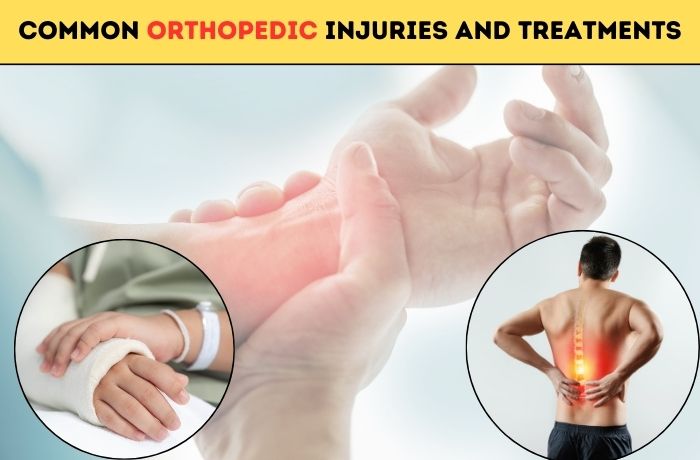Welcome, readers, to an informative guide to orthopedic injuries and their treatment. Whether you’re an athlete, a fitness enthusiast, or simply someone navigating the trials and challenges of everyday life, understanding common orthopedic injuries is paramount. From broken bones to joint pain, these conditions can significantly impact our quality of life. But fear not, with proper knowledge and treatment, recovery is possible and often fast. So let’s explore this interesting topic together.
Orthopedic injuries include various conditions affecting the musculoskeletal system, including bones, joints, muscles, ligaments, tendons, and nerves. These injuries can result from trauma, overuse, degeneration, or underlying medical conditions. Here’s an overview of some common orthopedic injuries and their treatments:
Types of Injuries:
1. Fractures (Broken Bones) :
Broken bones. Fractures can vary in severity from hairline fractures to complete fractures. Symptoms include pain, swelling, bruising, and deformity. Treatment depends on the type and location of the fracture and may include casting, splinting, or surgery.
Treatment of fractures involves different approaches depending on the type, location, and severity of the injury. Initial immobilization with casting or splinting is used to stabilize the fracture and prevent further displacement. For displaced or complex fractures, reduction techniques such as manual closed reduction or surgical open reduction may be required to realign the bones. Internal fixation methods, such as metal implants or intramedullary nails, provide stability and support to the fractured bone, while external fixation with an external fixator may be used in certain cases.
Schedule your consultation with Dr. Rajeev Gawhale at the Bone and Joint Care Clinic in Phursungi, for Fracture Treatment in Phursungi
2. Sprains and Strains:
Sprains occur when ligaments (tissues that connect bones) are stretched or torn. Strains are injuries to muscles or tendons (tissues that connect muscles to bones). Both cause pain, swelling, and difficulty using the affected joint.
Treatment for sprains and strains typically involves a combination of rest, ice, compression, and elevation (RICE) in the acute phase to reduce pain and inflammation. Nonsteroidal anti-inflammatory drugs (NSAIDs) and analgesics may be used for pain relief, while physiotherapy plays an important role in rehabilitation, focusing on strengthening, flexibility, and range of motion exercises. Bracing or splinting may assist healing, and a progressive return to activity is recommended once pain and swelling have subsided. Surgery is rarely necessary and is reserved for severe cases where conservative measures have failed or for extensive ligament or tendon damage.
3. Dislocations:
When bones at a joint are forced out of their normal position. Dislocations cause severe pain, deformity, and loss of function. They require urgent medical attention to properly reposition the bones and prevent complications.
Treatment for dislocations commonly involves closed reduction, in which the dislocated joint is manipulated back into place, often under sedation or anesthesia. After reduction, the joint is immobilized with splints or braces to support and stabilize it during healing. Rehabilitation with physiotherapy is essential to restore strength, flexibility, and range of motion in the joint and surrounding muscles. Medications such as pain relievers and muscle relaxants may be prescribed for symptom management.
In cases of severe damage or recurrent instability, surgery may be required for open reduction and possible soft tissue repair.
4. Rotator Cuff Tears:
The rotator cuff is a group of muscles and tendons that stabilize the shoulder joint. Tears can occur due to overuse, injury, or age-related wear and tear. Symptoms include pain, weakness, and difficulty raising the arm.
Treatment for rotator cuff tears varies depending on the severity of the tear and individual patient factors. Non-surgical options such as rest, activity modification, physiotherapy, and NSAIDs are often recommended for mild to moderate tears. Corticosteroid injections may provide temporary relief from pain and inflammation. In cases where conservative measures do not relieve symptoms, or for more severe tears, surgical options such as arthroscopic or open repair may be considered.
Postoperative rehabilitation, including physical therapy, plays a critical role in restoring shoulder function and preventing re-injury.
Get help from an orthopedic surgeon:
If you have persistent pain, limited mobility, or a suspected fracture, see an orthopedic surgeon. They can diagnose the underlying condition, recommend the most appropriate treatment plan, and guide you on your path to recovery.
For expert orthopedic care, consider Dr. Rajeev Gawhale at Bone and Joint Care Clinic. Dr. Gawhale is a highly skilled and experienced orthopedic surgeon in Phursungi dedicated to providing complete care for all your musculoskeletal needs.
Conclusion:
Orthopedic injuries can create unexpected challenges in life. However, with knowledge and the right medical support, we can overcome these obstacles with resilience and grace. Remember, your health is your most precious asset, deserving of unwavering attention and care. So take the first step toward healing today and prepare for a future filled with strength, mobility, and vitality.






